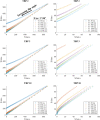Rapid 2D variable flip angle method for accurate and precise T1 measurements over a wide range of T1 values
- PMID: 34031938
- PMCID: PMC8365751
- DOI: 10.1002/nbm.4542
Rapid 2D variable flip angle method for accurate and precise T1 measurements over a wide range of T1 values
Abstract
Purpose: To perform dynamic T1 mapping using a 2D variable flip angle (VFA) method, a correction for the slice profile effect is needed. In this work we investigated the impact of flip angle selection and excitation RF pulse profile on the performance of slice profile correction when applied to T1 mapping over a range of T1 values.
Methods: A correction of the slice profile effect is proposed, based on Bloch simulation of steady-state signals. With this correction, Monte Carlo simulations were performed to assess the accuracy and precision of 2D VFA T1 mapping in the presence of noise, for RF pulses with time-bandwidth products of 2, 3 and 10 and with flip angle pairs in the range [1°-90°]. To evaluate its performance over a wide range of T1 , maximum errors were calculated for six T1 values between 50 ms and 1250 ms. The method was demonstrated using in vitro and in vivo experiments.
Results: Without corrections, 2D VFA severely underestimates T1 . Slice profile errors were effectively reduced with the correction based on simulations, both in vitro and in vivo. The precision and accuracy of the method depend on the nominal T1 values, the FA pair, and the RF pulse shape. FA pairs leading to <5% errors in T1 can be identified for the common RF shapes, for T1 values between 50 ms and 1250 ms.
Conclusions: 2D VFA T1 mapping with Bloch-simulation-based correction can deliver T1 estimates that are accurate and precise to within 5% over a wide T1 range.
Keywords: T1 mapping; slice excitation profile; variable flip angle.
© 2021 The Authors. NMR in Biomedicine published by John Wiley & Sons Ltd.
Figures









References
-
- Taylor AJ, Salerno M, Dharmakumar R, Jerosch‐Herold M. T1 mapping: basic techniques and clinical applications. JACC: Cardiovasc Imaging. 2016;9:67‐81. - PubMed
-
- Deoni SCL, Rutt BK, Peters TM. Rapid combined T 1 and T 2 mapping using gradient recalled acquisition in the steady state. Magn Reson Med. 2003;49(3):515‐526. - PubMed
-
- Look DC, Locker DR. Time saving in measurement of NMR and EPR relaxation times. Rev Sci Instrum. 1970;41(2):250‐251.
Publication types
MeSH terms
LinkOut - more resources
Full Text Sources
Other Literature Sources
Medical

